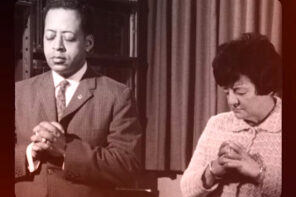My competent colleagues have collectively conspired to bring us the latest news from Caprica on an ongoing basis. So I’ll leave the Capricologizing to them. But I wanted to note a couple things surrounding the show that I think fills out some of the interest in its relation to religion: its advertising and the reception of the show as a potentially religious event in itself.
The SyFy channel obviously paid a hefty sum to the New York Times and other outlets for advertising Caprica. But, er, it worked. At least for me. I’m no longer a regular, prime-time telly watcher, having become one of the millions who are perpetually two seasons behind, but thanks to little red envelopes in my mailbox I’m not totally lost. (Speaking of, I’m in the midst of season 3 of Lost, season 3 of The Wire, and season 2 of 30 Rock.)
But the advertising image of a seductive, unashamed “Eve” (who is “Zoe,” from the Greek, meaning “life”) with a bitten apple, alongside the words “The Future of Humanity begins with a bite,” tempted my theological desires. The SyFy Channel utilized its space on the New York Times online edition by providing three radio buttons: one to watch the trailer (an obvious option), a second for “the cast” (also obvious) and a third for “New York Times Articles” (not so obvious for a Friday night show geared toward teenagers). Roll over that third button and up pop links to six different Times articles from the past couple years (see pic). The fineprint at the bottom tells us “The re-publication of these articles is sponsored by SyFy. The editorial staff of the New York Times was not involved in this production.” So someone at SyFy was assigned the task of looking through articles in the Times archives relevant to the show. Their foray into the more highbrow New York Times readership is interesting; with links to articles on the future of religion, the future of humanity, and, more importantly, the link between these two possible futures.
Well, that was it. I had to bite. And all that is just the beginning of the theo-logic that pervades Caprica. The narrative itself is fascinating, with many intrigues already covered in RD. Even so, much of it is not made for a middle-aged male like myself. Its audience is a mixture of that from Buffy to Charmed, merged of course with Battlestar. All this is interesting in itself since these shows continually revolve around things supernatural, and one might begin to question: Who is this audience who seems to want more and more stories about life beyond this one that we can readily perceive? Is this a religious interest? Does it come from growing up in a secularized society that wants to know more than this physical reality?
These questions take me directly into the other aspect of Caprica that needs exploring: the audience and reception of the show. What I have in mind here runs along the lines of what Lynn Schofield Clark has been working on for a number of years, and was most relevantly brought out in her 2003 book From Angels to Aliens: Teenagers, the Media, and the Supernatural. Through extensive interviews with teenagers and their families, Clark uncovers some interesting ways in which the media continues to shape the religious sensibilities of contemporary youth. While US teenagers today may relate less to traditional religious structures, they are finding meaning (with concomitant symbols, terms, and even rituals) in and through mass media. Buffy, Harry Potter, Lord of the Rings, and other television and film productions provide a storehouse of myths and rituals that make sense to contemporary youth. While these productions don’t necessarily guide the every move and thought of teenagers, they nonetheless supply a wealth of cultural expressions that enliven and even replace traditional religious beliefs and practices in their lives today.
So, what I look forward to is not so much the unfolding of the actions within Caprica, but the unfolding of what can only be called religious feelings, actions, and thoughts in the lives of the people who watch; not as casual observers but as a generation adrift and searching for meaning, order, and purpose.




